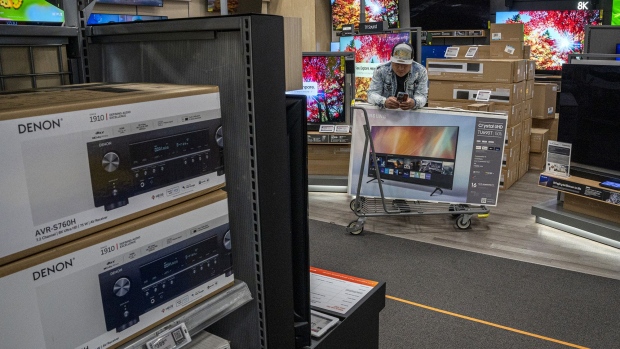Jan 18, 2023
US Retail Sales Slide by Most in a Year in Broad-Based Decline
, Bloomberg News

(Bloomberg) -- US retail sales fell by the most in a year and business equipment production slumped, raising concerns that the economy is losing momentum under the weight of tighter Federal Reserve policy.
The value of overall retail purchases broadly decreased 1.1% in December after a downwardly revised 1% drop in the prior month, Commerce Department data showed Wednesday. Separate figures showed a 1.3% decline in factory output last month that wrapped up the weakest quarter for manufacturing since the onset of the pandemic.
Taken together, the data show a consumer that’s losing steam and business investment falling, portending weaker growth and raising concerns that the economy may be inching closer to a recession. Combined with easing inflation, the figures put the Fed on track to further slow the pace of interest-rate hikes.
“The impact of a year of very aggressive central bank tightening and quantitative tightening are starting to bite the economy and they’re biting hard,” Bob Michele, chief investment officer at JPMorgan Asset Management, told Bloomberg Surveillance.
Ten of 13 retail categories fell last month, including motor vehicles, furniture and personal care stores. The value of sales at gasoline stations slumped 4.6% as prices steadily dropped. Excluding gasoline and autos, retail sales fell 0.7%. The figures aren’t adjusted for inflation.
While a strong jobs market has supported shoppers, Americans are still feeling strained — the saving rate is near a record low and credit-card balances have surged.
The data cap a year in which retail sales rose 9.2%, the second-most ever in figures back to 1993, though it also reflects rapid inflation. Resilient spending has been a source of frustration for the Fed as it tries to weaken demand across the economy, and consumers have played a role in keeping prices elevated.
Read more: US Consumer Spending Growing at Slower Pace, NY Fed Survey Finds
The S&P 500 opened higher and Treasuries rallied on hardened bets that the Fed will downshift to a quarter-point hike in two weeks and follow suit in March. A separate report Wednesday showed a measure of wholesale prices posted the biggest monthly drop since the start of the pandemic, adding to signs that inflationary pressures are cooling.
Traders lowered where they see rates peaking by a couple of basis points, to about 4.88%, and continue to price in around a half percentage point of easing by the end of the year. In contrast, Fed officials in December projected rates peaking around 5.1% and staying there through 2023.
Manufacturing Weakness
Fed data Wednesday highlighted the many challenges the nation’s manufacturers are contending with, including weaker global economic conditions, higher borrowing costs and restrained spending on consumer goods. As concerns permeate about a possible recession, there’s also a risk that businesses will pull back on capital investment in an effort to reduce costs.
The 2% slump in the production of business equipment in December was the most since February 2021. Including the prior month’s drop, the back-to-back decreases were the most since the onset of the pandemic.
And on a quarterly basis, the annualized 2.5% drop in the final three months of the year was the sharpest since pandemic lockdowns shuttered facilities. The decline in output was broad, including decreases in machinery, motor vehicles and furniture.
What Bloomberg Economics Says...
“A pullback in retail spending reflects a reversion in goods demand back toward the pre-pandemic trend, as well as higher borrowing costs... There’s downside risk to that reading with restaurant sales — a proxy for spending on services — deteriorating at year-end.”
—Eliza Winger, economist
To read the full note, click here
For most of the year, Americans have been spending more of their dollars on services, but December was broadly weak. Sales at restaurants and bars — the only service-sector category in the report — declined 0.9% last month, the biggest drop in nearly a year, Commerce data showed.
December, at the tail end of the holiday-shopping season, is traditionally a solid month for retail sales. However, a wide variety of discounts may have contributed to the weaker figures, especially in categories like electronics and apparel.
So-called control group sales — which are used to calculate gross domestic product and exclude food services, auto dealers, building materials stores and gasoline stations — dropped 0.7%, the most in a year.
The retail sales report can be difficult to draw concrete conclusions from since the data aren’t adjusted for inflation and mostly only capture spending on goods. A fuller picture of December household demand, which includes both price-adjusted figures and services spending, will be released next week.
Other data Wednesday showed US homebuilder sentiment increased in January for the first time since the end of 2021 as mortgage rates continued to retreat from the highest level in two decades.
--With assistance from Jordan Yadoo, Alex Tanzi and Alister Bull.
(Adds industrial production data)
©2023 Bloomberg L.P.






